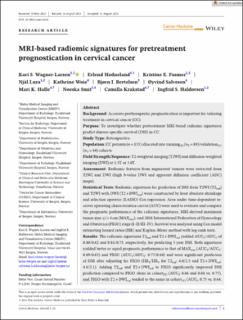| dc.contributor.author | Wagner-Larsen, Kari Strøno | |
| dc.contributor.author | Hodneland, Erlend | |
| dc.contributor.author | Fasmer, Kristine Eldevik | |
| dc.contributor.author | Lura, Njål | |
| dc.contributor.author | Woie, Kathrine | |
| dc.contributor.author | Bertelsen, Bjørn | |
| dc.contributor.author | Salvesen, Øyvind Olav | |
| dc.contributor.author | Halle, Mari Kyllesø | |
| dc.contributor.author | Smit, Noeska Natasja | |
| dc.contributor.author | Krakstad, Camilla | |
| dc.contributor.author | Haldorsen, Ingfrid S. | |
| dc.date.accessioned | 2024-01-17T11:59:14Z | |
| dc.date.available | 2024-01-17T11:59:14Z | |
| dc.date.created | 2023-10-30T13:57:19Z | |
| dc.date.issued | 2023 | |
| dc.identifier.issn | 2045-7634 | |
| dc.identifier.uri | https://hdl.handle.net/11250/3112148 | |
| dc.description.abstract | Background
Accurate pretherapeutic prognostication is important for tailoring treatment in cervical cancer (CC).
Purpose
To investigate whether pretreatment MRI-based radiomic signatures predict disease-specific survival (DSS) in CC.
Study Type
Retrospective.
Population
CC patients (n = 133) allocated into training(T) (nT = 89)/validation(V) (nV = 44) cohorts.
Field Strength/Sequence
T2-weighted imaging (T2WI) and diffusion-weighted imaging (DWI) at 1.5T or 3.0T.
Assessment
Radiomic features from segmented tumors were extracted from T2WI and DWI (high b-value DWI and apparent diffusion coefficient (ADC) maps).
Statistical Tests
Radiomic signatures for prediction of DSS from T2WI (T2rad) and T2WI with DWI (T2 + DWIrad) were constructed by least absolute shrinkage and selection operator (LASSO) Cox regression. Area under time-dependent receiver operating characteristics curves (AUC) were used to evaluate and compare the prognostic performance of the radiomic signatures, MRI-derived maximum tumor size ≤/> 4 cm (MAXsize), and 2018 International Federation of Gynecology and Obstetrics (FIGO) stage (I–II/III–IV). Survival was analyzed using Cox model estimating hazard ratios (HR) and Kaplan–Meier method with log-rank tests.
Results
The radiomic signatures T2rad and T2 + DWIrad yielded AUCT/AUCV of 0.80/0.62 and 0.81/0.75, respectively, for predicting 5-year DSS. Both signatures yielded better or equal prognostic performance to that of MAXsize (AUCT/AUCV: 0.69/0.65) and FIGO (AUCT/AUCV: 0.77/0.64) and were significant predictors of DSS after adjusting for FIGO (HRT/HRV for T2rad: 4.0/2.5 and T2 + DWIrad: 4.8/2.1). Adding T2rad and T2 + DWIrad to FIGO significantly improved DSS prediction compared to FIGO alone in cohort(T) (AUCT 0.86 and 0.88 vs. 0.77), and FIGO with T2 + DWIrad tended to the same in cohort(V) (AUCV 0.75 vs. 0.64, p = 0.07). High radiomic score for T2 + DWIrad was significantly associated with reduced DSS in both cohorts.
Data Conclusion
Radiomic signatures from T2WI and T2WI with DWI may provide added value for pretreatment risk assessment and for guiding tailored treatment strategies in CC. | en_US |
| dc.language.iso | eng | en_US |
| dc.publisher | Wiley | en_US |
| dc.rights | Navngivelse 4.0 Internasjonal | * |
| dc.rights.uri | http://creativecommons.org/licenses/by/4.0/deed.no | * |
| dc.title | MRI-based radiomic signatures for pretreatment prognostication in cervical cancer | en_US |
| dc.type | Journal article | en_US |
| dc.type | Peer reviewed | en_US |
| dc.description.version | publishedVersion | en_US |
| dc.rights.holder | Copyright 2023 The Author(s) | en_US |
| cristin.ispublished | true | |
| cristin.fulltext | original | |
| cristin.qualitycode | 1 | |
| dc.identifier.doi | 10.1002/cam4.6526 | |
| dc.identifier.cristin | 2190042 | |
| dc.source.journal | Cancer Medicine | en_US |
| dc.source.pagenumber | 20251-20265 | en_US |
| dc.identifier.citation | Cancer Medicine. 2023, 12 (20), 20251-20265. | en_US |
| dc.source.volume | 12 | en_US |
| dc.source.issue | 20 | en_US |

